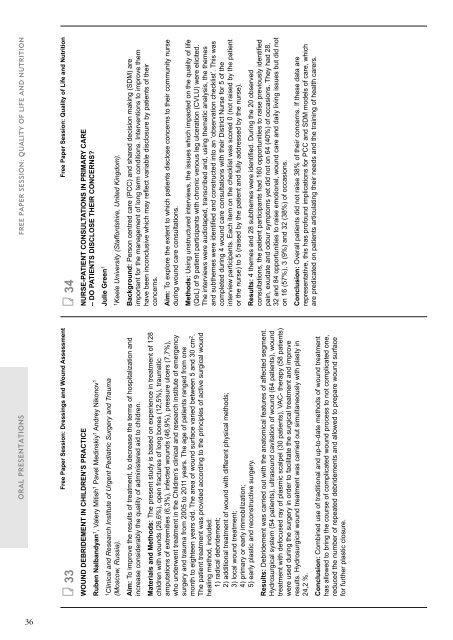Create successful ePaper yourself
Turn your PDF publications into a flip-book with our unique Google optimized e-Paper software.
ORAL PRESENTATIONS<br />
33<br />
WOUND DEBRIDEMENT IN CHILDREN’S PRACTICE<br />
Free Paper Session: Dressings and Wound Assessment<br />
Ruben Nalbandyan 1 , Valery Mitish 1 Pavel Medinskiy 1 Andrey Nikonov 1<br />
1 Clinical and Research Institute of Urgent Pediatric Surgery and Trauma<br />
(Moscow, Russia).<br />
Aim: To improve the results of treatment, to decrease the terms of hospitalization and<br />
increase considerably the quality of administered aid to children.<br />
Materials and Methods: The present study is based on experience in treatment of 128<br />
children with wounds (26,6%), open fractures of long bones (12,5%), traumatic<br />
amputations of extremities (6,3%), infected wounds (46,9%), pressure ulcers (7,7%),<br />
who underwent treatment in the Children’s clinical and research institute of emergency<br />
surgery and trauma from 2005 to 2011 years. The age of patients ranged from one<br />
month to eighteen years old. The area of wound surface varied between 5 and 30 cm 2 .<br />
The patient treatment was provided according to the principles of active surgical wound<br />
healing method, included:<br />
1) radical debridement;<br />
2) additional treatment of wound with different physical methods;<br />
3) local wound treatment;<br />
4) primary or early immobilization;<br />
5) early plastic and reconstructive surgery.<br />
Results: Debridement was carried out with the anatomical features of affected segment.<br />
Hydrosurgical system (54 patients), ultrasound cavitation of wound (64 patients), wound<br />
treatment with defocused ray of plasmic scalpel (30 patients), VAC- therapy (58 patients)<br />
were used during the surgery in order to facilitate the surgical treatment and improve<br />
results. Hydrosurgical wound treatment was carried out simultaneously with plasty in<br />
24,2 %.<br />
Conclusion: Combined use of traditional and up-to-date methods of wound treatment<br />
has allowed to bring the course of complicated wound process to not complicated one,<br />
reduced the number of repeated debridements and allowed to prepare wound surface<br />
for further plastic closure.<br />
FREE PAPER SESSION: QUALITY OF LIFE AND NUTRITION<br />
34<br />
Nurse-patient consultations in primary care<br />
– do patients disclose their concerns?<br />
Free Paper Session: Quality of Life and Nutrition<br />
Julie Green 1<br />
1 Keele University (Staffordshire, United Kingdom).<br />
Background: Person centred care (PCC) and shared decision making (SDM) are<br />
important for the management of long term conditions. Interventions to improve them<br />
have been inconclusive which may reflect variable disclosure by patients of their<br />
concerns.<br />
Aim: To explore the extent to which patients disclose concerns to their community nurse<br />
during wound care consultations.<br />
Methods: Using unstructured interviews, the issues which impacted on the quality of life<br />
(QoL) of 9 patient participants with chronic venous leg ulceration (CVLU) were elicited.<br />
The interviews were audiotaped, transcribed and, using thematic analysis, the themes<br />
and subthemes were identified and constructed into an ‘observation checklist’. This was<br />
completed during 4 wound care consultations with their District Nurse for 5 of the<br />
interview participants. Each item on the checklist was scored 0 (not raised by the patient<br />
or the nurse) to 5 (raised by the patient and fully addressed by the nurse).<br />
Results: 4 themes and 28 subthemes were identified. During the 20 observed<br />
consultations, the patient participants had 160 opportunities to raise previously identified<br />
pain, exudate and odour symptoms yet did not on 64 (40%) of occasions. They had 28,<br />
32 and 84 opportunities to raise emotional, wound care and daily living issues but did not<br />
on 16 (57%), 3 (9%) and 32 (38%) of occasions.<br />
Conclusion: Overall patients did not raise 38% of their concerns. If these data are<br />
representative, this has profound implications for PCC and SDM models of care, which<br />
are predicated on patients articulating their needs and the training of health carers.<br />
36






